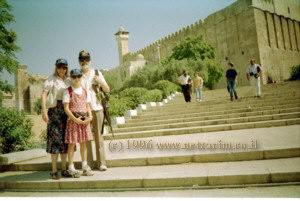Khai•yei′ Sâr•âh′ 5th Eve

Avᵊrâ•hâmꞋ Remarries Qᵊturâh1
After the death of SârꞋâh, Avᵊrâ•hâmꞋ remarried Hâ•gârꞋ,1 and they had 6 more children together, plus grandchildren. But Avᵊrâ•hâmꞋ willed everything to Yi•tzᵊkhâqꞋ. He gave gifts to the children of Qᵊturâh and sent them away to the lands of the east, which became the Arabian lands.
Avᵊrâ•hâmꞋ Dies, Buried in Mᵊâr•at′ ha-Ma•khᵊpeil•âhꞋ
 |
| Pâ•qidꞋ Yi•rᵊmᵊyâhꞋu, Karen and |
 |
So Avᵊrâ•hâmꞋ lived to be 1752 and when he died his two sons, Yi•tzᵊkhâqꞋ and Yi•shᵊm•â•eilꞋ buried him in the Mᵊâr•at′ ha-Ma•khᵊpeil•âhꞋ, in the field that Avᵊrâ•hâmꞋ had purchased from Ëphᵊr•onꞋ of the bᵊn•eiꞋ Kheit, overlooking Ma•mᵊreiꞋ — and where SârꞋâh was buried.
After the death of Avᵊrâ•hâmꞋ, Ël•oh•imꞋ blessed his son Yi•tzᵊkhâqꞋ, who settled in Bᵊeir la-KhaiꞋ Ro•iyꞋ, in the eastern Sin•aiꞋ.
Yi•shᵊm•â•eilꞋ Sires 12 Arab Tribal Patriarchs
 to Shur Yishmaeil descendants harvardpolitics dot com 250x377.png) |
| Kha•vil•âhꞋ (Ethiopia) "going Syria-ward" to Shur; Yi•shᵊm•â•eilꞋ's descendants (in orange). Locations of Kha•vil•âhꞋ and descendants of Yi•shᵊm•â•eilꞋ3 © 2015 Yi•rᵊmᵊyâhꞋu Bën-Dâ•widꞋ (basic map: harvardpolitics.com). |
Yi•shᵊm•â•eilꞋ lived to be 1374 and fathered 12 sons, each of whom became a city-king. The descendants of Yi•shᵊm•â•eilꞋ dwelled from Kha•vil•âhꞋ to Shur (in western Sin•aiꞋ), which is adjacent to Egypt (going Syria-ward); and he ruled over all his brothers.

Optional parental preparation:
- Note 1 – Tar•gumꞋ Pseudo-Yo•nâ•tânꞋ specifies (bᵊ-Reish•itꞋ 25.1) that åàåñéó àáøäí åðñéá àéúà åùîà ÷èåøä äéà äâø ã÷èéøà ìéä îï ùéøåéà (Qᵊturâh, meaning "bound" in Aramaic, is one and the same as Hâ•gârꞋ, who was already bound to Avᵊrâ•hâmꞋ in marriage).

- Note 3 – Proposed locations of ancient Kha•vil•âhꞋ, associated with Gan EiꞋdën, are, literally, all over the map. Some scholars locate Kha•vil•âhꞋ in southeast Mesopotamia at the northern tip of the Persian Gulf. Others on the east side of the Red Sea in the Arabian peninsula and Yemen. But the land described as known for its fine gold deposits, famed in the ancient Middle East, was Punt, south of Egypt (now Ethiopia). Further, the Arabian peninsula going Syria-ward branching northeast does not lead to Shur and, thus, must be eliminated.

- Note 4 – Contrary to simplistic fablizing, the average lifespan in this era was under 30 years. Simply assuming lunar years and converting to solar years would yield a lifespan for Yi•shᵊm•â•eilꞋ of just under 12 years old; not nearly enough to sire 12 sons even though, in ancient times, 12 years old was regarded as the threshhold marriageable age. 137 solar years would require that Yi•shᵊm•â•eilꞋ lived more than 4½ normal lifespans — fablizing. However, the theory of some scholars that a "century" was sometimes added as an acknowledgment of great respect would suggest 37 solar years plus an honorary century. And 37 years old was 7 years beyond the usual lifespan, very old for that era but not beyond reason and seems to corroborate this hypothesis, as it also allows the siring of 12 sons (plus however many unmentioned daughters).

Questions you might anticipate that your child might raise and be prepared to discuss:
- Note 2 – How could Avᵊrâ•hâmꞋ live 175 years? This answer is not so simple. But these events occurred during the transition from lunar to solar calendars, when "years" were lunar (a month today) and changing to solar years that we know today. It seems likely that Avᵊrâ•hâmꞋ's years were calculated partially in the solar calendar (e.g., perhaps 75 solar years like we know today) with a "century of respect" added in to elevate him more to the company of earlier persons of note whose ages were expressed in lunar "years" (months). Thus, simplistic assumptions aside, determining the life spans of ancient peoples is more guesswork than science. During the transition from lunar to solar calendar, some scholars also suggest that persons of note were "awarded" great ages to match their achievements, perhaps while trimming their ages toward the solar calendar. If, for example, the 75 refers to his age in solar years (plus a century awarded out of respect), that would equate to 900 lunar years (i.e., months), plus the century awarded out of respect. Mᵊtu•shë•Ꞌlakh lived only a bit longer, to 969 (lunar) "years" — a bit short of 80 solar years on modern calendars.

Google+ registered author & publisher

